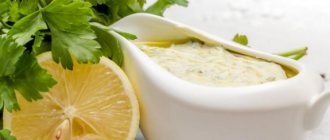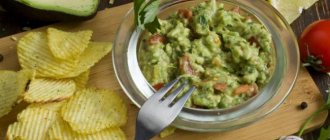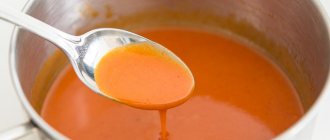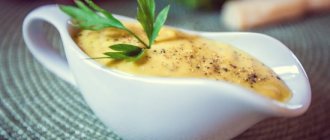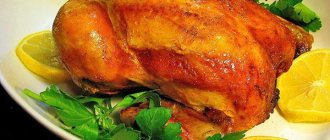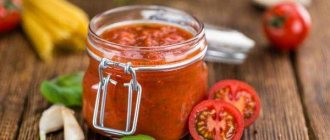Classic hollandaise sauce
It is traditionally prepared in a water bath, but can also be made using a blender. The calorie content of classic hollandaise sauce is 316 kcal, which makes one serving. Prepare the hollandaise sauce in 15 minutes.
Ingredients:
- three yolks;
- 130 g oil drain;
- two pinches of salt;
- ground black pepper;
- one and a half tsp. lemon juice.
Preparation:
- Add salt to the yolks, melt the butter without bringing to a boil.
- Beat the yolks in a blender until they become a fluffy white mass.
- Pour the melted cooled butter into the mixture drop by drop, while whisking constantly.
- Whisk until the mixture thickens.
- Add pepper and lemon juice and beat for another 35 seconds.
The finished sauce is similar in consistency to cream - thick and glossy. The sauce is served warm. It needs to be heated in a water bath.
Little secrets
Don’t try to make things easier and simply cook Hollandaise over a fire, without a water bath. All its tenderness and thickness are obtained only by simmering in a water bath.
If the yolks are slightly white, lemon juice or wine will help correct the situation. The selected liquid must be quickly added to the contents of the pan and stirred thoroughly.
If you want the gravy to not spread and hold its shape, add the whipped whites just before serving and stir them gently. Hollandaise with proteins can also be served cold; it does not lose either its taste or consistency.
When choosing spices for this amazing sauce, try not to overdo it with spicy notes. The taste value of the gravy lies in its milky-creamy harmony, complemented by the fresh sourness of lemon. Salt to taste, but you don’t need to salt, the salt contained in the oil will be enough.
Hollandaise sauce with white wine
You can add white wine to the hollandaise sauce ingredients. Makes one serving, calorie content – 379 kcal. The hollandaise sauce takes 20 minutes to prepare.
Required ingredients:
- oil drain – 100 g;
- one tbsp white wine;
- three yolks;
- ground pepper and salt;
- one tsp instant broth;
- a pinch of sugar;
- one tbsp lemon juice;
- three spoons of cream.
Cooking steps:
- Melt the butter and pour hot water into a bowl.
- In another smaller bowl, combine the wine with the broth, add sugar and salt, lemon juice and pepper.
- Add the yolks to the mixture and whisk everything with a whisk.
- Place the bowl of sauce in a bowl of hot water and whisk until white foam appears.
- Pour in the oil in portions, stirring the sauce constantly.
- Pour the sauce into a saucepan and place on low heat, whisk until thickened.
Ingredients:
- 175 g oil drain;
- two l. Art. water;
- spices;
- two l. Art. lemon juice;
- 4 yolks.
Preparation step by step:
- Melt the butter in a frying pan over low heat. Remove the foam and let the oil cool.
- Add water to the yolks and beat for 30 seconds.
- Place the yolks in a water bath and beat for three minutes.
- Remove from heat and add cooled butter in portions, beating the yolks.
- Add lemon juice and spices.
You can serve salmon with hollandaise sauce prepared according to the recipe.
Hollandaise sauce with cream
- egg yolks – 3 pcs.;
- butter – 70 g;
- heavy cream – 50 ml;
- lime juice – 40 ml;
- salt, white pepper - to taste.
Cooking method:
- Melt the butter in any way convenient for you, let it cool.
- Add salt and pepper to the cream, stir well.
- Place the egg yolks in a separate container and pour in the lime juice.
- Place the yolks in a water bath. Whisk them vigorously until the yolk mass becomes fluffy and slightly lighter.
- Add cream without stopping stirring. When the mixture begins to thicken again, begin adding oil.
- When all the butter is in the bowl with the yolks, heat and whisk the sauce until thick.
- When the desired consistency is reached, remove the bowl of sauce from the water bath. Add pepper and beat with a mixer for another three minutes.
Poached egg with hollandaise sauce
This dish has a name - eggs Benedict. It will take half an hour to prepare Hollandaise sauce with a poached egg. Makes two servings, 628 kcal.
Required ingredients:
- two eggs;
- three yolks;
- 80 g oil drain;
- 1 spoon of paprika;
- 1 spoon of lemon juice;
- bread - 2 slices;
- 4 slices of ham;
- 1 spoon of vinegar;
- salt.
Preparation:
- Beat the yolks in a blender and add lemon juice and paprika.
- Melt the butter and cool. Pour in a stream into the yolks, whisking constantly.
- Pour the sauce into a saucepan and heat in a water bath. Whisk until it begins to thicken.
- Remove from heat and pour into a cold container to prevent curdling.
- Place the cooled sauce in the refrigerator for half an hour.
- Toast the bread on both sides in a toaster, grill or dry frying pan.
- Poach eggs: Break eggs into a bowl, each one separately.
- Add vinegar to a saucepan with water and heat to a boil, but do not boil.
- Stir the water with a spoon to create a “funnel” and pour the eggs one at a time into the funnel.
- Simmer over low heat for five minutes. The water should not boil during cooking.
- Place the eggs on a napkin to remove excess water.
- Place ham on slices of bread and eggs on top. Drizzle hollandaise sauce over sandwiches.
Poached eggs with hollandaise sauce are perfect for breakfast and snacks.
A classic French sauce with a pleasant lemon aroma. Hollandaise sauce consists of
from egg yolks and lemon juice, heated to a creamy consistency, to which butter is mixed. It is not as widely used in our latitudes as it is for one simple reason: it is served immediately after serving while still warm. Accordingly, it is almost impossible to store it for more than two hours at home. Hollandaise sauce is served with asparagus, cauliflower, broccoli, boiled fish, and egg dishes.
There are two main ways to make hollandaise sauce
: complex and simple. In the first case, the yolks are first heated in a water bath, and then oil is added to them. In the second case, hot oil is poured into the cold yolks. The sauce prepared in the first, traditional way is thicker, but it is very easy to spoil. I only succeeded the third time, after half a dozen eggs and almost half a kilogram of butter went into the trash can. Just for fun, I prepared the sauce the second way – it worked the first time. The sauces tasted no different. And if there is no difference, why the extra torment? Now I prepare this sauce only in the second way, using a blender or mixer.
Hollandaise sauce
Total and active cooking time – 20 minutes Cost – $2.2 Calories per 100 g – 577 kcal
Sauce for asparagus
If you haven’t tried cooking asparagus yet, we will correct this omission, and in our recipe we will prepare two dishes at once: hollandaise sauce and asparagus. First, let's cook the asparagus. We will need:
- asparagus – 3 kg;
- water – 3 liters;
- sugar and salt - 2 tablespoons each;
- butter – 1 tablespoon.
Place a pan of water on the fire, add butter, salt and sugar, and let the contents of the pan boil. We need to clean the asparagus stalks, cut off the rough lower part. Place the asparagus in boiling water and boil for 10-15 minutes. Keep in mind that green stems cook faster and have a milder taste. If asparagus is overcooked, it will lose its elasticity and taste. Now let's start preparing the sauce. For him you need to take:
- raw egg yolks – 4 pieces;
- butter – 125 grams;
- lemon juice – 1 tablespoon;
- salt – 1/8 teaspoon;
- cream 20% - 2 tablespoons.
Preparation:
- For utensils, you need to stock up on a deep saucepan and a saucepan suitable for a water bath.
- Take a deep saucepan. Separate the yolks from the whites and place them in a saucepan. Add lemon juice. Place in a water bath. Have a wooden spoon and use it to mash the yolks while heating.
- Divide the butter into three equal parts. Add one piece to the yolks, continue rubbing until the butter is completely melted. Then add the remaining pieces of butter, proceeding in the same way as with the first piece. Do not let the water in the pan boil; the heating temperature should be approximately 60 degrees. If you have a cooking thermometer, take the time to measure the water in the pan.
- After the butter has completely melted with constant stirring, remove the sauce from the heat, add cream and salt. The gravy is ready. Serve it hot with asparagus.
Your most important task is to prevent the yolks from boiling! You will have to stand near the stove and pay maximum attention to the sauce. The sauce is ideal for boiled and baked asparagus.
How to make hollandaise sauce
Ingredients:
Egg yolk – 3 pcs. Lemon juice – 2 tbsp. Salt – ¼ tsp. White pepper – 1 pinch Butter – 110 + 110 g.
Preparation:
Pour the yolks, lemon juice, salt and pepper into the bowl of a blender or food processor. Close the lid and stir at maximum speed for 30 seconds.
Remove the lid and, still stirring at high speed, pour in the hot butter in a very thin stream, literally drop by drop. The oil will warm the yolks; By pouring it in very slowly, you give the yolks time to absorb the oil. When 2/3 of the oil is gone, the sauce will turn into a thick cream, and then you can add the remaining oil a little faster.
Place all the resulting sauce from the blender bowl into a bowl and beat another 110 g of butter into it with a wire whisk or mixer.
In the event of a disaster:
If the sauce refuses to thicken or the finished sauce curdles, remove it from the blender bowl. Then, at high speed, pour it back drop by drop.
How to keep the sauce warm.
Hollandaise sauce is served warm, not hot; if you keep it too warm, it will become liquid or curdle. If you made the sauce ahead of time, place the sauce pan in a warm place on the stove or in a bain marie of lukewarm water. Or add a minimal amount of butter to the sauce, and before serving, heat the rest of the butter until it bubbles and whisk into the sauce in a thin stream.
Hollandaise is one of the five main sauces in French cuisine. It is well known as a key ingredient in eggs Benedict and is also often served with vegetables. Its international name sounds like “Hollandez”. Its name implies Dutch origins, but the actual history behind the name of this product is unknown.
Such a name is documented in English as early as 1573, although without a prescription. The first recorded classic recipe for hollandaise sauce is found in an English cookbook from 1651. It goes like this: “Make a sauce of good fresh butter with vinegar, salt, nutmeg and egg yolk.”
It was first mentioned in Dutch cuisine in 1667. Thus, the popular theory that its name comes from the country of invention is chronologically untenable.
In this article we will look at ways to prepare the named sauce.
Hollandaise sauce for eggs Benedict or How to make a five-star hotel at home
Did you know that deviled eggs were invented by a New York chef in 1980? Since then, this dish has been on the menu of elite restaurants and five-star hotels. If you wish, you can organize a delicious breakfast at home. To make this you will need: two poached eggs, crispy bacon and, of course, hot Dutch sauce of French origin. Well, if you add crispy toast or a freshly baked British muffin, the dish will come out truly perfect.
The base is toasted croutons, bacon or meat is placed on top of them, then baked eggs are poured on top with Hollandaise.
Step-by-step cooking instructions
- Unsweetened waffles or round-shaped slices cut from bread are suitable for toast. The slices should first be fried without adding oil on both sides.
- Fry the meat, carefully place on croutons.
- Eggs Benedict are boiled without the shell. It is important to break them into a deep plate so that the yolks remain intact. It is better to take separate forms for each egg. Add water to the container, bring to a boil, add salt, add vinegar and carefully pour the yolk so that the white adheres to it as tightly as possible. Cook for 2 to 5 minutes.
Lifehacks for housewives!
Only fresh eggs are suitable for preparing this dish. 3-4 day options will not work.
The colder the eggs are, the better they will retain their shape, so you should only take them out of the refrigerator before cooking.
It is important to boil eggs over low heat, so you should reduce the gas immediately after boiling.
The longer you cook the eggs, the softer, “creamy” they will become.
- The eggs are pulled out using a slotted spoon, previously wrapped in a napkin, and placed on bread with meat.
- To prepare Hollandaise sauce for eggs
, you can take one yolk, 50 g butter, 1.5 tbsp. l. white wine/vinegar, natural lemon juice (1.5-2 teaspoons), salt - to taste (per two persons). - Finely chop the butter. Heat the yolk in white wine, add salt, and place in a steam bath. Add oil, stir until smooth.
- A lighter option - all the ingredients of the sauce can be blended with a blender, but in this case the sauce will turn out liquid.
- Pour hollandaise sauce over toasted, aromatic toasts, pepper, and add herbs for decoration.
Delicious eggs Benedict are ready, now the best restaurant is in your home without wasting time and extra effort.
Experienced cooks know many secrets on how to make perfect hollandaise sauce. Its preparation, although not particularly difficult, still requires knowledge of some subtleties.
- Would you like the sauce to be thicker? Reduce the amount of butter relative to the yolks. For example, 100 grams, instead of the traditional 150. The consistency of the sauce can be adjusted by adding melted butter.
- In order not to cook an omelette instead of a sauce, you should strictly monitor the temperature. Do not bring to a boil under any circumstances, otherwise lumps will form in the sauce. If such a problem occurs, remove the Hollandaise from the steam bath, lower the container into cold water, whisk thoroughly and continue cooking.
- Another secret is to add ice cubes, beat well, and put them back in the steam bath.
- To prevent the sauce from separating, add butter in small portions - the consistency should always be uniform. On average, the process of adding oil takes five to seven minutes, after which cooking must be completed.
- Natural lemon juice can be replaced with citric acid, previously diluted in boiling water.
- You can reduce the thickness of the sauce by adding broth, vegetable broth, and cream. With whipped egg whites it will be more fluffy, and if cooked with vegetable broth it will be less nutritious.
- Hollandaise is a delicate product. Usually it is not stored for a long time, but the sauce is prepared before serving. Vegetables are the “ideal partners” of French seasoning. The sauce goes well with boiled asparagus, zucchini and even chicory.
- Lemon juice is sometimes replaced with regular or balsamic vinegar - this makes the seasoning more spicy and aromatic. Additives in the form of crushed pepper, garlic, and capers can give hollandaise sauce a piquant taste. Experiment and you will succeed.
He identified five main, or “mother” sauces. Based on these five, you can prepare all the other sauces that every self-respecting French chef should know. Four of them were thickened with a toasted flour roux, and one - Hollandaise, or Hollandaise - was an emulsion of egg yolks and melted butter.
For more than 100 years, both French and all other cuisines have become much lighter, getting rid of bulky and complex recipes, but Hollandaise sauce is still relevant. The reason is that it goes equally well with vegetables, fish and eggs, including, of course, the world's best breakfast - eggs Benedict. To tell the truth, making hollandaise sauce is a little more difficult than the one we are very familiar with, but once you try it, no one will have to explain to you why it is needed.
How is it prepared?
As with other emulsion sauces (for example, mayonnaise), the egg in its composition is not heated, but serves as an emulsifier. This allows the immiscible oil and lemon juice to combine, which in turn produces a stable emulsion.
Classic Hollandaise sauce ingredients include:
- egg yolks;
- acidifying agent (wine vinegar or lemon juice);
- butter.
Also use salt and any type of pepper to taste. Often a little cream or water is added for a better combination of ingredients.
To make hollandaise sauce, combine beaten egg yolks with oil, lemon juice, salt and water. Heat gently while mixing. Some cooks use a double bottom pan to control the temperature.
Different recipes have different requirements. Some involve adding melted butter to heated yolks. Others require unmelted butter and yolks to heat together. Still others combine warm butter and eggs in a blender or food processor. Temperature control is critical as excessive heat can ruin the sauce.
The special thing about this product is that it can be easily frozen.
Hollandaise sauce: recipe from the chef
Every chef has his own secrets for making a wonderful sauce. For example, the British Raoul Lee first boils the yolks, gradually adding oil. This is a traditional 18th century recipe from the legendary French chef Auguste Escoffier. Other cooks, trying to enrich the taste, add a little white wine or wine vinegar to the sauce. And this is how Miss Xanthe Clay suggests preparing her signature dish - asparagus with hollandaise. In her opinion, the key to success is the right combination of ingredients:
- 140 g of asparagus per person;
- white wine – 4 tablespoons;
- black peppercorns – 7 pcs.;
- bay leaf – 2 pcs.;
- butter – 230 g;
- raw yolk – 4 pcs.
- Pour wine into a compact container, add bay leaves and pepper. Pour water (4 tbsp) and bring to a boil. Cool, strain.
- Heat the oil until white foam.
- Salt the yolks, add water (3 tablespoons), beat. Place in a steam bath and wait until the yolks lighten. Then gradually add melted butter. Mix. Add wine with bay leaf and pepper, salt. The consistency of the finished sauce should resemble medium-thick mayonnaise.
Lifehacks for housewives!
It is important not to overdo it with oil, add it gradually, and remove it from the steam bath in time, as the sauce may “curdle.” It is recommended to serve Hollandaise warm and store it in the refrigerator. Don't worry if the sauce hardens, it will taste silky and smooth again when exposed to hot foods.
How to cook
For cooking, use a small, thick ceramic bowl set in a heavy-bottomed saucepan. A special container for a water bath is also suitable:
- Place the egg yolks and cream in a bowl or the top of a double saucepan. Mix with a wire whisk until combined. The mixture should never be beaten, but it must be stirred: evenly, vigorously and continuously.
- Place the container in hot water. If you are using a bowl, there should be about 4cm of water in a regular saucepan. In double - it should not touch the top.
- Stir the sauce continuously and slowly, bring the water to a boil.
- Do not let the egg mixture boil. Stir very thoroughly so that there is no film at the bottom.
- Once the mixture has thickened to the consistency of cream, begin adding the cooled, melted butter with one hand while vigorously stirring the sauce with the other.
- Do this slowly so that each addition of butter is completely incorporated into the egg mixture.
- Then add lemon juice or vinegar a drop at a time and immediately remove the container from the heat.
- Add salt and a little cayenne pepper.
If you are careful, the hollandaise sauce should not curdle. If this does happen, don't despair. Add more oil. Transfer the sauce to another container and clean the bowl. Place a fresh egg yolk in it and start cooking again, using the curdled sauce instead of butter.
Step-by-step preparation
- Hollandaise sauce is prepared in a water bath. Place a saucepan on the fire with water poured into the bottom.
- Take a bowl that is the right size so that the bowl does not touch the bottom of the pan.
Take 3 eggs and separate the yolks from the whites. This can be done in several ways. The most traditional: use a knife to break the egg in half, being careful not to touch the yolk. Then, carefully transferring the yolk from one half of the shell to the other, pour the white into a separate bowl, and only one yolk remains in the shell. Did you know? Another method of separating the yolk from the white is less common, but no less effective. For this we need an empty plastic bottle. Next, carefully break the eggs into a bowl. Then we slightly squeeze the sides of the plastic bottle, bring its neck to the yolk and carefully release it. The yolk should be retracted. Next, we transfer it to the bowl and again squeeze the sides of the plastic bottle. The yolk is safely separated from the white. - At the same time, melt 4 tablespoons of butter in a bowl (but do not boil, and under no circumstances let it burn). It is better to use ready-made ghee. During the preparation of such oil, water and impurities are removed from it. It tastes very good and can be stored in the refrigerator for up to 12 months.
- Place 3 yolks in a bowl over a water bath.
- Add 1 teaspoon of tarragon vinegar to the yolks. It can be replaced with white wine vinegar or regular alcohol vinegar. It will add sourness to the sauce and give it an unusual texture.
- Place the bowl over a pan of boiling water and begin whisking. If you put the yolks directly on the fire, you will get not a sauce, but scrambled eggs.
- When the mixture has become creamy and thick, we begin to slowly add melted and slightly cooled butter into it in a thin stream.
A couple of tablespoons of oil and stir well. If you stir poorly, the yolks will not combine with the butter and the sauce will not be homogeneous. Then add more oil and beat again. And so on until the oil runs out. To keep the sauce warm, it is best to leave it in a warm water bath, after turning off the heat under the pan. - Add salt and freshly ground pepper to taste. Freshly ground pepper will add flavor and piquancy to the sauce.
- Fresh lemon juice will liven up the flavor of the sauce. Take one lemon, wash it and pour boiling water over it. Roll it between your palms or, placing it on the table, roll it a little to make it easier to squeeze out the juice. Cut off about a third of the lemon and squeeze its juice into the bowl with the sauce (we will need approximately 1 teaspoon).
- Mix everything well. The consistency of the sauce should be like a thick cream, that is, it should be held on the back of a spoon.
Cooking options and derivative sauces
As you can see, the classic recipe for Hollandaise sauce involves using yolks, butter and lemon juice (or vinegar) as a base. Over time, many different versions of this product and its derivatives have appeared. The most famous of them:
- Béarnsky. It is the most common derivative and is known as Béarnaise. Prepared by adding an acidifying agent (usually wine or balsamic vinegar) with shallots, fresh chervil, tarragon and (optional) crushed pepper. In some cases, no vinegar is added at all. Béarnaise sauce and its derivatives are often used on steaks or other hearty grilled meats, as well as fish.
- Shoron. This is a type of béarnaise sauce. It is prepared without tarragon or chervil, plus it contains tomato puree.
- Foyot (Valois). It is also a type of béarnaise sauce containing meat broth.
- Colbert. This is a foyot sauce with the addition of white wine.
- Paloise. Béarnaise sauce with mint instead of tarragon.
- Vin Blian. Hollandaise sauce with white wine and fish stock.
- Bavaruz. A type of hollandaise sauce with cream, horseradish and thyme.
- Moutard or Girondine. It is Hollandaise with Dijon mustard.
- Maltase. Hollandaise sauce with orange zest and juice.
- Muslin, also known as Chantilly. It is Hollandaise with whipped cream. It also has several variations. One of them involves the addition of sherry, the other - whipped egg whites instead of cream.
- Nouzette. Hollandaise sauce made with melted butter.
Hollandaise sauce history
Anyone unfamiliar with this product thinks that hollandaise sauce actually comes from Holland. In fact, he has no Dutch roots. Its homeland is France, and it was created in the 17th century in Normandy. At that time, there was a “tense” with butter in France; it was brought from the Netherlands.
That’s why the cream sauce was called Hollandaise, and then the name stuck, and no one changed it. Even after the situation with oil changed for the better.
If there is an alternative historical version, it says that this product originated in France during the war with the Dutch, in the same 17th century, and that is why it has such a name. Which version is more truthful is unknown, it is only clear that the sauce was born during the reign of King Louis XIV, and that France is its homeland.
A modern take on eggs Benedict
The classic recipe for Hollandaise sauce comes in different variations. To prepare eggs Benedict, a slightly simplified version is often used. What kind of dish is this? This is a classic French breakfast consisting of two halves of an English muffin topped with a poached egg, bacon or ham, and hollandaise sauce. Despite its French origins, this dish was first popularized in New York. There are many variations on the basic recipe.
The key to making the perfect Eggs Benedict is fresh eggs and good lemon juice. In fact, this is a very simple recipe that requires just a little skill and experience. It may take several tries to get a tender and tasty dish.
How to cook Eggs Benedict
Because making butter and egg sauce requires precise temperature and timing, make sure all of your ingredients are measured and ready the day before. All you need is:
- four eggs plus the same number of yolks separately;
- two English muffins, halved (or four slices of toast);
- two tablespoons each of fresh lemon juice and water;
- 100 grams of cold salted butter, cut into 1 cm cubes;
- salt and white pepper - to taste;
- fresh grated nutmeg - optional.
Recipe No. 3
What do you need
- sweet and sour apple – 1 piece;
- soy sauce – 100 milliliters;
- tomato paste – 150 ml;
- peach or apricot juice – 200 ml;
- dry white wine – 100 ml;
- onions - one small onion;
- cognac - two tables. spoons;
- garlic - two cloves;
- allspice peas - three pieces;
- black peppercorns – 10 pieces;
- vegetable oil – two tablespoons;
- cloves - two pieces;
- cardamom - one piece;
- apple cider vinegar – 50 ml;
- granulated sugar - four teaspoons;
- starch - teaspoon;
- ground cinnamon - a pinch;
- ground nutmeg - a pinch;
- fresh ginger – 10 grams.
Procedure
- Finely crushed cloves, cardamom and pepper in a mortar, pressed garlic and ginger and finely chopped onion into an enamel bowl, add cinnamon, nutmeg, wine and soy sauce. Place on the fire, bring to a boil and cook with constant stirring for about three minutes. Remove from heat, cover and leave for 20 minutes. Stir every five minutes.
- Peel the apple, remove the core, chop finely. Heat a frying pan with vegetable oil, place the apple in it, add juice and bring to a boil. Cover with a lid and keep on low heat until the apples are soft, but do not allow them to burn.
- Beat the infused mixture of soy sauce and spices in a blender, add the apple mixture to it and beat again. If desired, all this can also be passed through a sieve so that there are no large particles.
- At the next stage, add cognac, tomato and sugar to the mixture, put on fire, let it boil and cook at low boil, stirring, for about two minutes.
- Pour vinegar and starch previously diluted in cold water (three tablespoons) into the mixture.
- Southern sauce is ready. All that remains is to put it in jars and put it in the refrigerator. It should be approximately 900 milliliters.
How to cook a poached egg at home?
Pour water into a saucepan and bring it to a low boil. Add salt and turn the heat to low. Fill a medium-sized container with cold water and place it next to the stove. Carefully crack one egg into a small bowl, being careful not to break the yolk.
Then stir the water in the pan so that it forms a funnel in the center. Pour the egg into it and carefully run a spoon along the bottom so that it does not stick. Because you want the yolk to remain runny, you'll need to watch the cooking time carefully. It should take no more than 3-4 minutes. After this, carefully move the egg into a container of cold water to stop it from heating. Repeat with the remaining three eggs.
Preparing the sauce
Next, you need to make the hollandaise sauce. To do this, whisk the egg yolks, fresh lemon juice and water in a heatproof glass or ceramic bowl set over a small saucepan of simmering water. Slowly add the butter, a few cubes at a time, until it is combined with the yolks, stirring constantly.
Continue cooking for another minute or two until the sauce thickens. Season with salt and white pepper. Remove from heat immediately. Classic hollandaise sauce with lemon juice is ready.
Hollandaise sauce best recipes
We will tell you the best recipes for hollandaise sauce at home, and it will not be difficult for you to prepare it in your usual kitchen. Stock up on inspiration and all the necessary products, get ready for an interesting creative process and get to work!
Classic hollandaise sauce
First, let's prepare a classic Hollandaise.
You can proudly serve poached eggs or another delicious dish with it, and you will definitely pleasantly surprise your guests.
Calorie content – 114 kcal.
- Eggs – 3 pcs.;
- Butter – 150 gr.;
- Lemon juice – 1 tbsp;
- Salt, black or white pepper - a pinch.
- Place the saucepan on the fire and melt the butter in it. You can also simply melt it in the microwave. The main thing is to turn it off in time so that it does not start to boil.
- We separate the eggs into whites and yolks; we only need the yolks. Place them in a large bowl.
- Season them with salt and pepper, add lemon juice and a tablespoon of cold water.
- Next, beat the egg mixture with a whisk or fork, but not with a mixer.
- Place the bowl with eggs in a water bath. They are not boiled, but only slightly heated, this is important.
- We continue to actively beat the eggs all the time, and pour melted butter into them in a thin stream.
- If lumps appear, add cold water and continue to actively stir the sauce.
Finishing cooking
Heat English muffins or toast. Using a large spoon, place an egg on each bun half or piece of toast, drizzle generously with hollandaise sauce and sprinkle fresh nutmeg on top (optional).
You can also add a slice or two of bacon or ham, but the classic version calls for fresh eggs and a mild sauce. American and Canadian versions of the dish suggest adding smoked salmon or seafood.
Hollandaise sauce, which by the way was invented in France, goes well with boiled and steamed vegetables, fish and eggs. It's easy to prepare. The process is somewhat similar to . But there are some subtleties and success is not always possible the first time.
Ingredients:
- chicken yolks - 2 pieces;
- butter - 100 g;
- lemon juice - 1 teaspoon;
- white wine vinegar - 1 teaspoon;
- salt and ground black pepper to taste.
Chicken yolks, previously separated from whites, salt and pepper. Then beat with a mixer (you can use a blender, food processor, whoever has what). Bring lemon juice and wine vinegar to a boil in a frying pan, add to the beaten yolks and beat again. In the same frying pan, melt the butter cut into pieces over low heat. As soon as the oil begins to boil, slowly and in a thin stream pour it into the yolks and at the same time beat with a mixer.
To thicken the hollandaise sauce, place the container with it on and continue to work with the mixer until we get a thick, homogeneous and silky mass.
It is important here to ensure that the sauce does not begin to separate. The decomposition process begins at 63 degrees Celsius. The first time I made hollandaise sauce, I made this exact mistake. To correct the situation, you need to beat another yolk in a clean container and, continuing to beat, gradually add the failed curdled sauce.
Classic Hollandaise sauce: beneficial properties and preparation technology
So, if you are planning to make hollandaise sauce, the classic recipe includes the following ingredients:
- butter (100-150 g);
- egg yolks (2 large or 3 small);
- natural lemon juice (30 ml/1 tbsp);
- freshly ground pepper;
- salt, water (30 ml).
- Melt the butter, cool to natural temperature.
- Pour water into a large container, bring to a boil and leave to simmer over low heat. Pour the yolks into a smaller container, then pour in the lemon juice, stirring, and heat in a water bath (comfortable temperature - 75-80 degrees). You need to make sure that the bottom of the container does not come into contact with hot water.
- Beat the yolks until foamy, carefully add the melted butter. It is important to do this slowly to prevent the sauce from curdling.
- At the very end, add salt and pepper. Beat for half a minute.
- Check that the sauce is prepared correctly: there should be no lumps in it, and the consistency should resemble custard. Serve hot.
